初中英语八种时态大全-最新版
初中英语语法总结8种时态
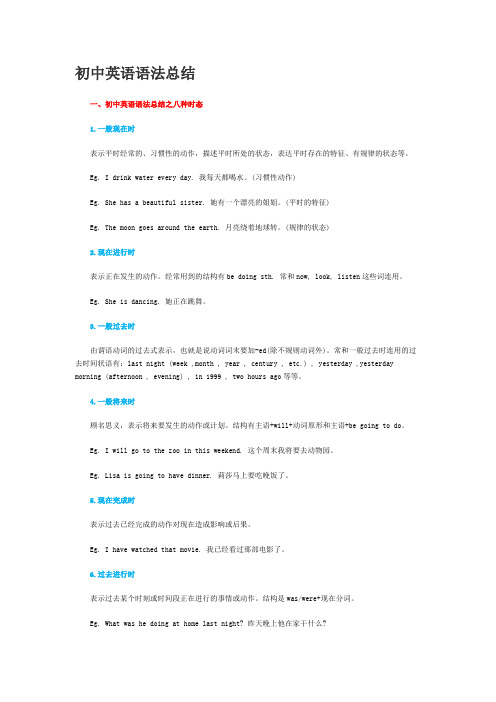
初中英语语法总结一、初中英语语法总结之八种时态1.一般现在时表示平时经常的、习惯性的动作,描述平时所处的状态,表达平时存在的特征、有规律的状态等。
Eg. I drink water every day. 我每天都喝水。
(习惯性动作)Eg. She has a beautiful sister. 她有一个漂亮的姐姐。
(平时的特征)Eg. The moon goes around the earth. 月亮绕着地球转。
(规律的状态)2.现在进行时表示正在发生的动作。
经常用到的结构有be doing sth. 常和now, look, listen这些词连用。
Eg. She is dancing. 她正在跳舞。
3.一般过去时由谓语动词的过去式表示,也就是说动词词末要加-ed(除不规则动词外)。
常和一般过去时连用的过去时间状语有:last night (week ,month , year , century , etc.) , yesterday ,yesterday morning (afternoon , evening) , in 1999 , two hours ago等等。
4.一般将来时顾名思义,表示将来要发生的动作或计划。
结构有主语+will+动词原形和主语+be going to do。
Eg. I will go to the zoo in this weekend. 这个周末我将要去动物园。
Eg. Lisa is going to have dinner. 莉莎马上要吃晚饭了。
5.现在完成时表示过去已经完成的动作对现在造成影响或后果。
Eg. I have watched that movie. 我已经看过那部电影了。
6.过去进行时表示过去某个时刻或时间段正在进行的事情或动作。
结构是was/were+现在分词。
Eg. What was he doing at home last night? 昨天晚上他在家干什么?7.过去将来时表示过去的某时以后将要发生的动作。
(完整版)初中英语八种时态总结归纳
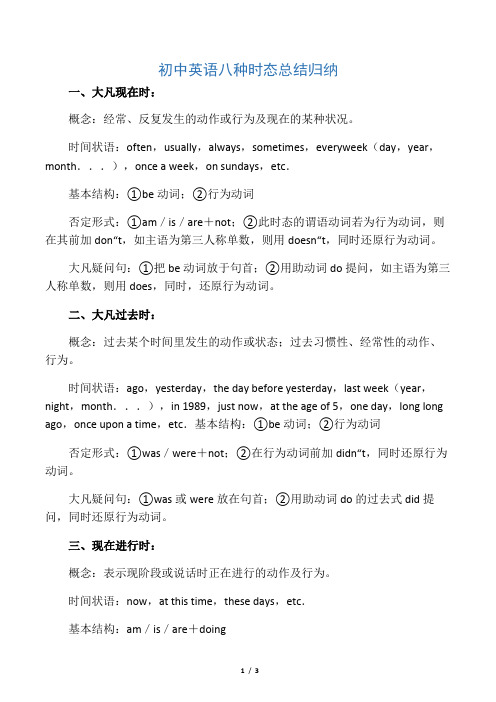
初中英语八种时态总结归纳一、大凡现在时:概念:经常、反复发生的动作或行为及现在的某种状况。
时间状语:often,usually,always,sometimes,everyweek(day,year,month...),once a week,on sundays,etc.基本结构:①be动词;②行为动词否定形式:①am/is/are+not;②此时态的谓语动词若为行为动词,则在其前加don“t,如主语为第三人称单数,则用doesn“t,同时还原行为动词。
大凡疑问句:①把be动词放于句首;②用助动词do提问,如主语为第三人称单数,则用does,同时,还原行为动词。
二、大凡过去时:概念:过去某个时间里发生的动作或状态;过去习惯性、经常性的动作、行为。
时间状语:ago,yesterday,the day before yesterday,last week(year,night,month...),in 1989,just now,at the age of 5,one day,long long ago,once upon a time,etc.基本结构:①be动词;②行为动词否定形式:①was/were+not;②在行为动词前加didn“t,同时还原行为动词。
大凡疑问句:①was或were放在句首;②用助动词do的过去式did提问,同时还原行为动词。
三、现在进行时:概念:表示现阶段或说话时正在进行的动作及行为。
时间状语:now,at this time,these days,etc.基本结构:am/is/are+doing否定形式:am/is/are+not+doing大凡疑问句:把be动词放在句首四、过去进行时:概念:表示过去某段时间或某一时刻正在发生或进行的行为或动作。
时间状语:at this time yesterday,at that time或以when引导的谓语动词是大凡过去时的时间状语等。
初中八大时态总结
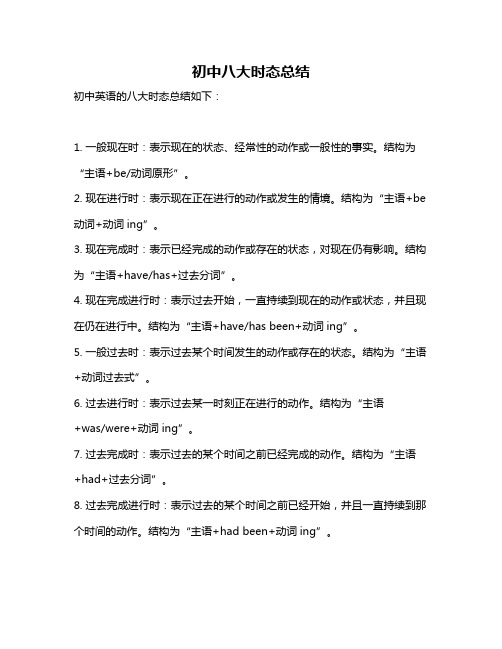
初中八大时态总结
初中英语的八大时态总结如下:
1. 一般现在时:表示现在的状态、经常性的动作或一般性的事实。
结构为“主语+be/动词原形”。
2. 现在进行时:表示现在正在进行的动作或发生的情境。
结构为“主语+be 动词+动词ing”。
3. 现在完成时:表示已经完成的动作或存在的状态,对现在仍有影响。
结构为“主语+have/has+过去分词”。
4. 现在完成进行时:表示过去开始,一直持续到现在的动作或状态,并且现在仍在进行中。
结构为“主语+have/has been+动词ing”。
5. 一般过去时:表示过去某个时间发生的动作或存在的状态。
结构为“主语+动词过去式”。
6. 过去进行时:表示过去某一时刻正在进行的动作。
结构为“主语
+was/were+动词ing”。
7. 过去完成时:表示过去的某个时间之前已经完成的动作。
结构为“主语+had+过去分词”。
8. 过去完成进行时:表示过去的某个时间之前已经开始,并且一直持续到那个时间的动作。
结构为“主语+had been+动词ing”。
以上是初中英语八大时态的总结,希望对你有所帮助。
(完整)初中英语八种时态详解
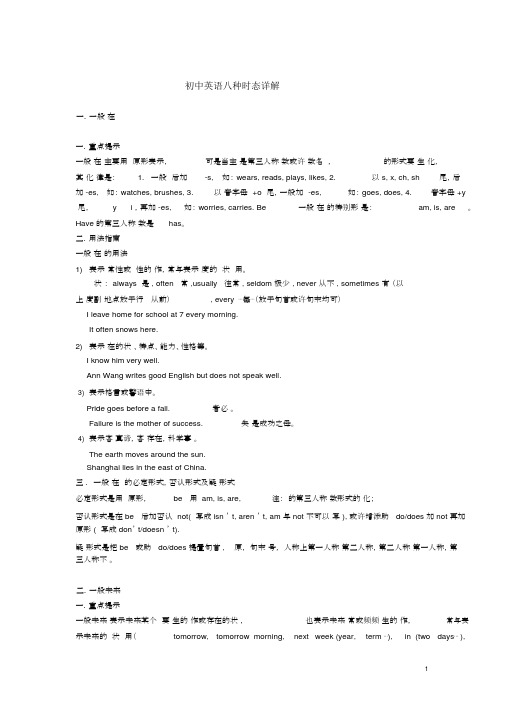
初中英语八种时态详解一.一般在一.重点提示一般在主要用原形表示,可是当主是第三人称数或许数名,的形式要生化,其化律是: 1.一般后加-s,如:wears, reads, plays, likes, 2.以s, x, ch, sh尾,后加 -es,如:watches, brushes, 3.以音字母+o尾,一般加-es,如:goes, does, 4.音字母+y 尾,y i ,再加 -es,如:worries, carries. Be一般在的特别形是:am, is, are。
Have 的第三人称数是has。
二.用法指南一般在的用法1)表示常性或性的作,常与表示度的状用。
状: always 是 , often 常 ,usually 往常 , seldom 极少 , never 从不 , sometimes 有(以上度副地点放于行从前), every ⋯每⋯(放于句首或许句末均可)I leave home for school at 7 every morning.It often snows here.2)表示在的状、特点、能力、性格等。
I know him very well.Ann Wang writes good English but does not speak well.3)表示格言或警语中。
Pride goes before a fall.者必。
Failure is the mother of success.失是成功之母。
4)表示客真谛,客存在,科学事。
The earth moves around the sun.Shanghai lies in the east of China.三 .一般在的必定形式,否认形式及疑形式必定形式是用原形,be 用 am, is, are,注:的第三人称数形式的化;否认形式是在 be 后加否认 not( 写成 isn ’ t, aren ’ t, am 与 not 不可以写 ), 或许增添助 do/does 加 not 再加原形 ( 写成 don’ t/doesn ’ t).疑形式是把 be 或助 do/does 提置句首 , 原,句末号,人称上第一人称第二人称,第二人称第一人称,第三人称不。
【初中】英语八大时态详细汇总

现在完成时意义:He has lived here for many years.2.强调后果/影响I have read the book .结构:时间状语:(1)since 的用法Since+时间点I have lived here since 2022.一段时间+ago I have lived here since two years ago.+从句(用一般过去时)常见句型:It is + 一段时间+since从句主句(完成时)+since(一般过去时)It is seven years since I met him last time.He has learned 2000 words since he went to school.(2)For+时间段We have known each other for five years.(3)already(用于肯定句中)/yet (用与否定句或疑问句中)just/everrecently( in recent years)before never等(just now是一般过去时的时间状语)I have just finished my homework.Have you ever seen one like this?(4So far /in the past few years等,表示:“目前为止”非延续性动词延续性动词非延续性动词延续性动词Borrow Keep Fall asleep Be asleep buy have Catch a cold Have a cold leave Be away Begin/start Be ondie Be dead open Be open Come (to)Be in/at close Be closed区分Have gone to去了没回Have been to去了回来(常与次数once/twice/基数词+times连用)Have been in在某地呆了多久例句:(1)You can’t see her because he has gone to Sibo.(2)He has been to Sibo twice.(3)He has been in this city for two years.备注:Here/there/home 不与介词连用。
初中英语8个时态归纳总结
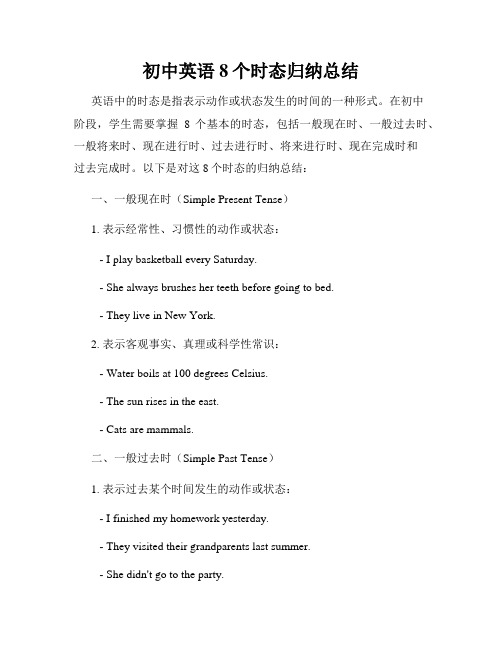
初中英语8个时态归纳总结英语中的时态是指表示动作或状态发生的时间的一种形式。
在初中阶段,学生需要掌握8个基本的时态,包括一般现在时、一般过去时、一般将来时、现在进行时、过去进行时、将来进行时、现在完成时和过去完成时。
以下是对这8个时态的归纳总结:一、一般现在时(Simple Present Tense)1. 表示经常性、习惯性的动作或状态:- I play basketball every Saturday.- She always brushes her teeth before going to bed.- They live in New York.2. 表示客观事实、真理或科学性常识:- Water boils at 100 degrees Celsius.- The sun rises in the east.- Cats are mammals.二、一般过去时(Simple Past Tense)1. 表示过去某个时间发生的动作或状态:- I finished my homework yesterday.- They visited their grandparents last summer.- She didn't go to the party.2. 表示过去的经历或习惯:- When I was young, I often went swimming. - He always ate breakfast at 8 o'clock.三、一般将来时(Simple Future Tense)1. 表示将来要发生的动作或事件:- I will go shopping tomorrow.- They are going to have a picnic next week. - She won't be late for the meeting.2. 表示将来的打算或意愿:- I am going to be a doctor when I grow up.- We will help you with your project.四、现在进行时(Present Continuous Tense)1. 表示现在正在进行的动作:- We are studying English at the moment.- He is playing soccer with his friends.- They aren't watching TV right now.2. 表示现阶段的趋势或变化:- The population is increasing rapidly.- More and more people are using smartphones.五、过去进行时(Past Continuous Tense)1. 表示过去某一时间段内正在进行的动作:- I was reading a book when the phone rang.- They were cooking dinner at 7 o'clock.2. 表示过去的同时发生的两个动作:- She was listening to music while doing her homework.六、将来进行时(Future Continuous Tense)1. 表示将来某一时间段内正在进行的动作:- Tomorrow, they will be flying to Paris.- I will be waiting for you at the station.2. 表示将来的预测或计划:- This time next month, I will be studying for my exams.七、现在完成时(Present Perfect Tense)1. 表示过去某一时间发生的动作对现在造成的影响或结果: - I have finished my homework, so I can watch TV now.- She has already eaten lunch.2. 表示过去某一时间内多次发生的动作:- We have visited that museum several times.八、过去完成时(Past Perfect Tense)1. 表示过去某一时间点之前已经完成的动作:- By the time they arrived, we had already left.- I had finished my work before the deadline.2. 表示过去的顺序或先后关系:- She realized that she had forgotten her keys after she locked the door.以上是初中英语的8个时态的归纳总结。
初中英语常用的有8种时态
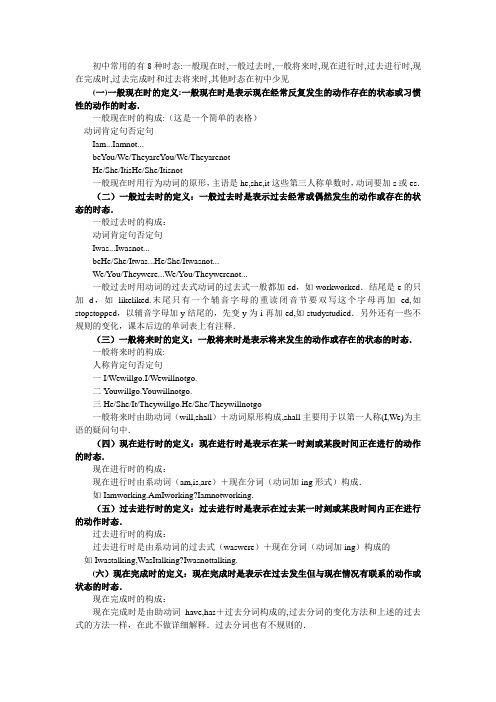
初中常用的有8种时态:一般现在时,一般过去时,一般将来时,现在进行时,过去进行时,现在完成时,过去完成时和过去将来时,其他时态在初中少见(一)一般现在时的定义:一般现在时是表示现在经常反复发生的动作存在的状态或习惯性的动作的时态.一般现在时的构成:(这是一个简单的表格)动词肯定句否定句Iam...Iamnot...beYou/We/TheyareYou/We/TheyarenotHe/She/ItisHe/She/Itisnot一般现在时用行为动词的原形,主语是he,she,it这些第三人称单数时,动词要加s或es.(二)一般过去时的定义:一般过去时是表示过去经常或偶然发生的动作或存在的状态的时态.一般过去时的构成:动词肯定句否定句Iwas...Iwasnot...beHe/She/Itwas...He/She/Itwasnot...We/You/Theywere...We/You/Theywerenot...一般过去时用动词的过去式动词的过去式一般都加ed,如workworked.结尾是e的只加d,如likeliked.末尾只有一个辅音字母的重读闭音节要双写这个字母再加ed,如stopstopped,以辅音字母加y结尾的,先变y为i再加ed,如studystudied.另外还有一些不规则的变化,课本后边的单词表上有注释.(三)一般将来时的定义:一般将来时是表示将来发生的动作或存在的状态的时态.一般将来时的构成:人称肯定句否定句一I/Wewillgo.I/Wewillnotgo.二Youwillgo.Youwillnotgo.三He/She/It/Theywillgo.He/She/Theywillnotgo一般将来时由助动词(will,shall)+动词原形构成,shall主要用于以第一人称(I,We)为主语的疑问句中.(四)现在进行时的定义:现在进行时是表示在某一时刻或某段时间正在进行的动作的时态.现在进行时的构成:现在进行时由系动词(am,is,are)+现在分词(动词加ing形式)构成.如Iamworking.AmIworking?Iamnotworking.(五)过去进行时的定义:过去进行时是表示在过去某一时刻或某段时间内正在进行的动作时态.过去进行时的构成:过去进行时是由系动词的过去式(waswere)+现在分词(动词加ing)构成的如Iwastalking,WasItalking?Iwasnottalking.(六)现在完成时的定义:现在完成时是表示在过去发生但与现在情况有联系的动作或状态的时态.现在完成时的构成:现在完成时是由助动词have,has+过去分词构成的,过去分词的变化方法和上述的过去式的方法一样,在此不做详细解释.过去分词也有不规则的.如Youhavetalked.Haveyoutalked?(七)过去完成时的定义:过去完成时表示在过去某一时间或动作以前已完成的行为或存在的状态.过去完成时的构成:过去完成时由助动词had(无人称和数的变化)+过去分词构成,其否定句式和疑问句式在结构上与现在完成时一样.如They/hehadreadit.Hadthey/hereadit?(八)过去将来时的定义:过去将来时表示从过去的观点看将来发生的动作或存在的状态.过去将来是的构成:过去将来时由助动词would+动词原形构成.如Hesaidhewouldcome.口诀记忆宾语从句宾语从句三姊妹,that,if/whether,wh-/how展风采。
初中英语语法八大时态总结(附答案)
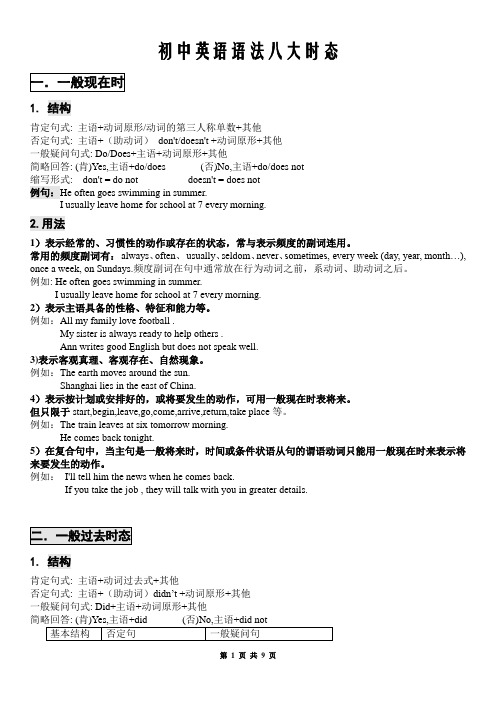
初中英语语法八大时态1.结构肯定句式: 主语+动词原形/动词的第三人称单数+其他否定句式: 主语+(助动词)don't/doesn't +动词原形+其他一般疑问句式: Do/Does+主语+动词原形+其他简略回答: (肯)Yes,主语+do/does (否)No,主语+do/does not缩写形式: don't = do not doesn't = does not例句:He often goes swimming in summer.I usually leave home for school at 7 every morning.2.用法1)表示经常的、习惯性的动作或存在的状态,常与表示频度的副词连用。
常用的频度副词有:always、often、usually、seldom、never、sometimes, every week (day, year, month…), once a week, on Sundays.频度副词在句中通常放在行为动词之前,系动词、助动词之后。
例如: He often goes swimming in summer.I usually leave home for school at 7 every morning.2)表示主语具备的性格、特征和能力等。
例如:All my family love football .My sister is always ready to help others .Ann writes good English but does not speak well.3)表示客观真理、客观存在、自然现象。
例如:The earth moves around the sun.Shanghai lies in the east of China.4)表示按计划或安排好的,或将要发生的动作,可用一般现在时表将来。
初中英语语法八大时态总结完整版
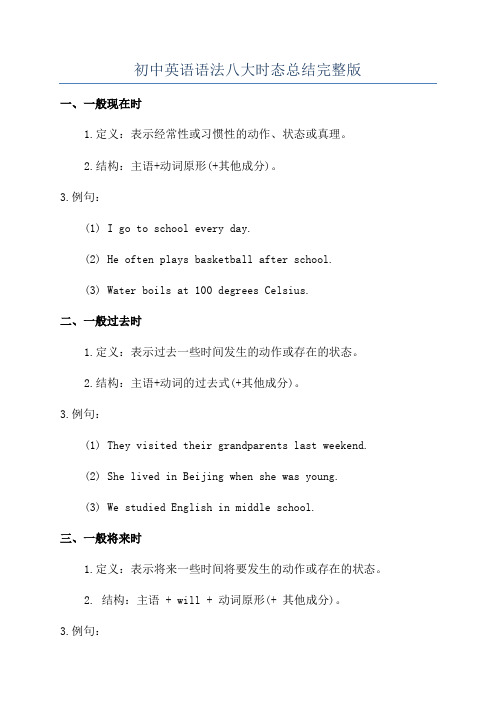
初中英语语法八大时态总结完整版一、一般现在时1.定义:表示经常性或习惯性的动作、状态或真理。
2.结构:主语+动词原形(+其他成分)。
3.例句:(1) I go to school every day.(2) He often plays basketball after school.(3) Water boils at 100 degrees Celsius.二、一般过去时1.定义:表示过去一些时间发生的动作或存在的状态。
2.结构:主语+动词的过去式(+其他成分)。
3.例句:(1) They visited their grandparents last weekend.(2) She lived in Beijing when she was young.(3) We studied English in middle school.三、一般将来时1.定义:表示将来一些时间将要发生的动作或存在的状态。
2. 结构:主语 + will + 动词原形(+ 其他成分)。
3.例句:(1) I will go to the park tomorrow.(3) We will have a party next week.四、现在进行时1.定义:表示现在正在进行的动作。
2. 结构:主语 + am/is/are + 动词-ing(+ 其他成分)。
3.例句:(1) She is reading a book right now.(2) They are playing soccer in the park.(3) We are having dinner at the moment.五、过去进行时1.定义:表示过去一些时间正在进行的动作。
2. 结构:主语 + was/were + 动词-ing(+ 其他成分)。
3.例句:(1) He was watching TV at 8 o'clock last night.(2) They were traveling in Europe during summer vacation.(3) We were studying when the phone rang.六、将来进行时1.定义:表示将来一些时间正在进行的动作。
初中英语八大时态

一、一般现在时:1.概念:经常、反复发生的动作或行为及现在的某种状况。
2.时间状语:always, usually, often, sometimes, every week (day, year, month...), once a week, on Sundays,3.基本结构:动词原形(如主语为第三人称单数,动词上要加(e)S)4.否定形式:am/is/are+not;此时态的谓语动词若为行为动词,则在其前加don't,如主语为第三人称单数,则用doesn't,通常还原行为动词。
5.一般疑问句:把be动词放于句首;用助动词do提问,如主语为第三人称单数,则用does,同时,还原行为动词。
6.例句:It seldom snows here.He is always ready to help others.Action speaks louder than words.二、一般过去时:1.概念:过去某个时间里发生的动作或状态;过去习惯性、经常性的动作、行为。
2.时间状语:ago, yesterday, the day before yesterday, last week(year, night, month…), in 1989, just now, at the age of 5, one day, long long ago, once upon a time, etc.3.基本结构:be动词;行为动词4.否定形式:was/were+not;在行为动词前加didn't,同时还原行为动词。
5.一般疑问句:was或were放于句首;用助动词do的过去式did 提问,同时还原行为动词。
6.例句:She often came to help us in those days.I didn't know you were so busy.三、现在进行时:1.概念:表示现阶段或说话时正在进行的动作及行为。
初中英语语法八大时态总结(完整版)
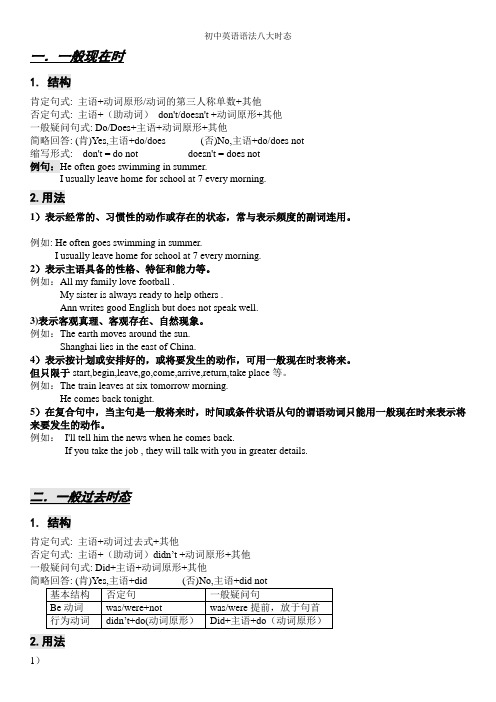
初中英语语法八大时态一.一般现在时1.结构肯定句式: 主语+动词原形/动词的第三人称单数+其他否定句式: 主语+(助动词)don't/doesn't +动词原形+其他一般疑问句式: Do/Does+主语+动词原形+其他简略回答: (肯)Yes,主语+do/does (否)No,主语+do/does not缩写形式: don't = do not doesn't = does not例句:He often goes swimming in summer.I usually leave home for school at 7 every morning.2.用法1)表示经常的、习惯性的动作或存在的状态,常与表示频度的副词连用。
例如: He often goes swimming in summer.I usually leave home for school at 7 every morning.2)表示主语具备的性格、特征和能力等。
例如:All my family love football .My sister is always ready to help others .Ann writes good English but does not speak well.3)表示客观真理、客观存在、自然现象。
例如:The earth moves around the sun.Shanghai lies in the east of China.4)表示按计划或安排好的,或将要发生的动作,可用一般现在时表将来。
但只限于start,begin,leave,go,come,arrive,return,take place等。
例如:The train leaves at six tomorrow morning.He comes back tonight.5)在复合句中,当主句是一般将来时,时间或条件状语从句的谓语动词只能用一般现在时来表示将来要发生的动作。
(完整word版)初中英语八种时态整理
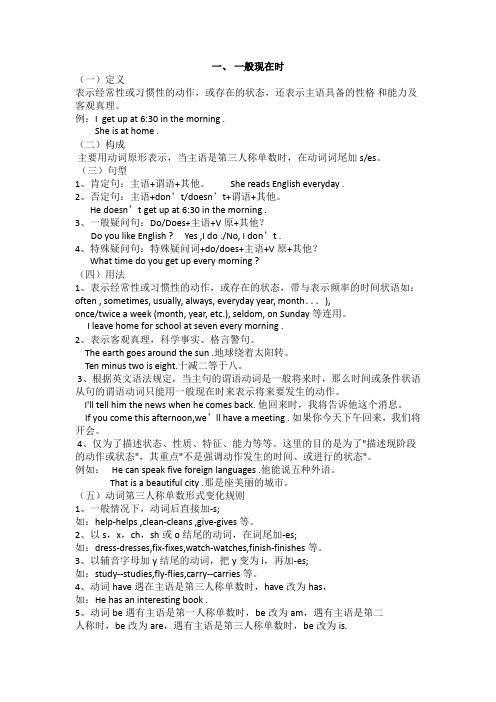
一、一般现在时(一)定义表示经常性或习惯性的动作,或存在的状态,还表示主语具备的性格和能力及客观真理。
例:I get up at6:30in the morning.She is at home.(二)构成主要用动词原形表示,当主语是第三人称单数时,在动词词尾加s/es。
(三)句型1、肯定句:主语+谓语+其他。
She reads English everyday.2、否定句:主语+don’t/doesn’t+谓语+其他。
He doesn’t get up at6:30in the morning.3、一般疑问句:Do/Does+主语+V原+其他?Do you like English?Yes,I do./No,I don’t.4、特殊疑问句:特殊疑问词+do/does+主语+V原+其他?What time do you get up every morning?(四)用法1、表示经常性或习惯性的动作,或存在的状态,带与表示频率的时间状语如:often,sometimes, usually, always, everyday year, month...),once/twice a week(month, year, etc.), seldom, on Sunday等连用。
I leave home for school at seven every morning.2、表示客观真理,科学事实、格言警句。
The earth goes around the sun.地球绕着太阳转。
Ten minus two is eight.十减二等于八。
3、根据英文语法规定,当主句的谓语动词是一般将来时,那么时间或条件状语从句的谓语动词只能用一般现在时来表示将来要发生的动作。
I'll tell him the news when he comes back.他回来时,我将告诉他这个消息。
If you come this afternoon,we’ll have a meeting.如果你今天下午回来,我们将开会。
(完整版)初中英语八种基本时态总结

初中英语基本时态总结Ⅰ、一般现在时1、概念:1)表示经常性或习惯性的动作,常与表示频度的时间状语连用。
时间状语:always, usually, often, sometimes, seldom, never, every day, twice a week, on Sunday, etc.(提问用How often)例:I leave home for school at 7 every morning.Tom gets up at 6:00 every morning.2)客观真理,客观存在,科学事实。
例:The earth moves around the sun. 地球绕太阳转动。
Shanghai lies in the east of China. 上海位于中国东部。
3)格言或警句。
例:Pride goes before a fall. 骄者必败。
注意:宾语从句中,即使主句是过去时,从句谓语是客观真理也要用一般现在时。
例:Columbus proved that the earth is round. 哥伦布证实了地球是圆的。
2、结构:表状态S+ am/is/are+ P (句中有实义动词不用be)表动作S+V原+O (若主语是单三人称,谓动加s/es。
)3、句式变化:变疑问,有be把be提到主语前;无be在主语前加do/does,谓动变为原形。
变否定,有be在be后加“not”;无be在主语后加don’t/doesn’t,谓动变为原形。
例:①They are in the classroom. →Are they in the classroom? Yes, they are./No, they aren’t. →They aren’t in the classroom②He often waters the flowers . → Does he often water the flowers?Yes, he does. / No, he doesn’t. →He doesn’t often water the flowersⅡ、一般过去时1、概念:1)表示在确定的过去时间里所发生的动作或存在的状态。
(完整word版)初中英语八大时态表
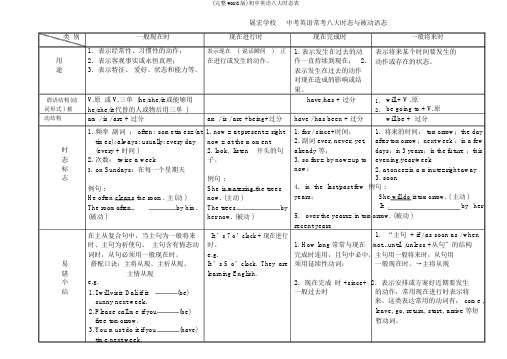
展宏学校中考英语常考八大时态与被动语态类别一般现在时现在进行时现在完成时一般将来时用途谓语结构(动词形式 ) 被动结构时态标志1.表示经常性、习惯性的动作;表示现在(说话瞬间)正2.表示客观事实或永恒真理;在进行或发生的动作。
3.表示特征、爱好、状态和能力等。
V.原或 V.三单 (he/she/it 或能够用he/she/it 代替的人或物后用三单 )am / is / are + 过分am / is / are +being+过分1. 频率副词: often;sometimes=(at 1. now = at present = righttimes); always; usually; every day now = at the moment(every + 时间 ) 2. look, listen开头的句2. 次数: twice a week子。
3. on Sundays:在每一个星期天例句 :例句 :She is watering the treesHe often cleans the room. 主(动 )now. (主动 )The roomoften by him.The trees by(被动 )her now. (被动 )1. 表示发生在过去的动表示将来某个时间要发生的作一直持续到现在; 2.动作或存在的状态。
表示发生在过去的动作对现在造成的影响或结果。
have/has + 过分 1.will + V .原2.be going to + V.原have / has been + 过分will be + 过分1. for / since+时间; 1.将来的时间: tomorrow;the day2. 副词 ever, never, yet,after tomorrow;next week ;in a fewalready 等;days;in 3 years;in the future ;this3. so far = by now=up to evening/year/weeknow; 2. at once=in a minute=right away3.soon4.in the last/past few 例句 :years;She will do it tomorrow. ( 主动 )It by her5.over the years= in tomorrow. (被动 )recent years在主从复合句中,当主句为一般将来It ’s 7 o’clock + 现在进行时、主句为祈使句、主句含有情态动时。
初中英语的八种时态

初中英语的八种时态一、一般现在时:表示经常、反复发生的动作或行为以及现在的某种状况。
时间状语:always 、usually、ofen 、sometimes ,every week(day,year, month……) ,once a week, on Sundays, etc.基本结构:○1be动词;○2行为动词否定形式:○1am/is/are+not○2此时态的谓语动词如果为行为动词,则在其前加don,t ,如果主语是第三人称,则用doesn,t ,同时还原行为动词。
一般疑问句:○1把be 动词放在句首○2用助动词do 提问,如主语为第三人称单数,则用does,同时还原行为动词。
二、一般过去时:表示过去某个时间里发生的动作或状态;过去习惯性、经常性的动作、行为。
时间状语:ago, yesterday, the day before yesterday,last week (year, month,night (i)2000,just now ,at the age of 10,one day ,long long ago,once upon a time ,etc.基本结构:○1be动词;○2行为动词否定形式:○1was/were+not ○2在行为动词前加didn,t,同时还原行为动词。
一般疑问句:○1把was或were放于句首○2用助动词do的过去式did 提问,同时还原行为动词。
三、现在进行时:表示现阶段或说话时正在进行的动作或行为。
时间状语:now ,at this time ,these days ,etc.基本结构:am /is /are+doing否定形式:am /is /are+not+doing一般疑问句:把be动词放于句首。
四、过去进行时:表示过去某段时间或某一时刻正在发生或进行的行为或动作。
时间状语:at this time yesterday,at that time 或以when 引导的谓语动词是一般过去时的时间状语等。
初中英语所有时态

初中英语所有时态1.一般现在时(do/does; is/am/are)①表示现在的情况、状态或特征。
例:He is a student.他是一个学生。
②表示经常性、习惯性动作。
例:He always helps others.他总是帮助别人。
③客观事实和普遍真理。
例:The earth moves the sun.地球绕着太阳转。
④表示一个按规定、计划或安排要发生的动作。
仅限于某些表示“来、去、动、停、开始、结束、继续”等的动词,可以与表示未来时间的状语搭配使用。
常见的用法是:飞机、火车、轮船、汽车等定期定点运行的交通方式。
例:The next train leaves at 3 o'clock this afternoon.下一趟火车今天下午3点开车。
⑤在时间、条件和让步状语从句中经常用一般现在(有时也用现在完成时)表示将的来事情。
(即:主将从现原则)例:I will call you as soon as I arrive at the airport.我一到机场就会给你打电话。
When you have finished the report, I will have waited for about 3 hours.等你完成这份报告的时候,我就已经等了将近3个小时了。
2. 现在进行时(am/is/are doing)①表示此时此刻正在发生的事情。
例:He is listning to the music now.他现在正在听音乐。
②表示目前一段时间内一直在做的事情,但不一定此时此刻正在做。
例:I am studying computer this term.这个学期我一直在学习计算机。
③现在进行时可以表示将来的含义。
瞬时动词的进行一定表将来。
例:I am leaving.我要离开了。
持续动词的进行只有有将来的时间状语或有将来语境中才表将来。
例:I am travelling next month.下个月我要去旅行。
(最新版)初中英语语法八大时态概述

(最新版)初中英语语法八大时态概述一、现在时态(Present Tense)1. 一般现在时:- 表示经常性、惯性的动作或状态:I play football every Sunday.(我每个星期天都踢足球。
)- 表示客观真理或普遍性事实:The sun rises in the east.(太阳从东方升起。
)2. 现在进行时:- 表示正在进行的动作:She is reading a book.(她正在看一本书。
)- 表示近期安排或打算:We are going to the movies tomorrow.(我们明天要去看电影。
)二、过去时态(Past Tense)1. 一般过去时:- 表示过去某个时间发生的动作或状态:He visited his grandparents last week.(他上周去看望了他的祖父母。
)2. 过去进行时:- 表示过去某一时刻正在进行的动作:I was studying when she called me.(她给我打电话的时候,我正在研究。
)三、将来时态(Future Tense)1. 一般将来时:- 表示将来某个时间将要发生的动作或状态:I will visit my friend next week.(我下周要去拜访我的朋友。
)2. 将来进行时:- 表示将来某一时刻正在进行的动作:They will be having dinner when we arrive.(当我们到达的时候,他们正在吃晚饭。
)四、现在完成时态(Present Perfect Tense)- 表示过去某个时间开始并一直延续到现在的动作或状态:I have lived here for 10 years.(我已经在这里住了10年了。
)五、过去完成时态(Past Perfect Tense)- 表示过去某个时间之前已经完成的动作或状态:She had already left when I arrived.(当我到达时,她已经离开了。
初中英语8大时态结构及用法,赶快收藏!

初中英语8大时态结构及用法,赶快收藏!时态无疑是初中英语最重要的语法内容,学好时态基本就拿下了语法的半壁江山。
今天总结的八种时态是大家在初中阶段必学必考的,复习时一定要加倍重视哦!一、一般现在时1、概念:表示经常发生的情况;有规律出现的情况;总是发生的;和事实真理。
2.时间状语: Always, usually, often, sometimes, every week (day, year, month…), once a week (day, year, month…), on Sundays (on Mondays…)3.基本结构:动词原形(如主语为第三人称单数,动词上要改为第三人称单数形式)4.否定形式:主语+am / is / are+not+其他;此时态的谓语动词若为行为动词,则在其前加don't,如主语为第三人称单数,则用doesn't,同时还原行为动词。
5.一般疑问句:把be动词放于句首;用助动词do提问,如主语为第三人称单数,则用does,同时,还原行为动词。
eg:①It seldom snows here.这里很少下雪。
②He is always ready to help others.他总是乐于帮助别人。
③Action speaks louder than words.事实胜雄辩。
二、一般过去时1.概念:过去某个时间里发生的动作或状态;过去习惯性、经常性的动作、行为。
2.时间状语:ago, yesterday, the day before yesterday, last week, last (year,ni ght,month…), in 1989, just now, at the age of 5, one day, long long ago, once upon a time,etc.3.基本结构:主语+动词的过去式或 be 的过去式+名词4.否定形式:主语+was / were+not+其他;在行为动词前加didn't,同时还原行为动词。
初中英语八种时态大全-最新版

八种时态一、一般现在时:概念:表示现阶段经常或习惯发生的动作或存在的状态,或说明主语的特征。
用法:A) 表示现在发生的动作、情况、状态和特征.B)经常性、习惯性动作。
常与频率副词连用.Eg。
:He always helps others。
(他总是帮助别人.)C) 客观事实和普遍真理.Eg。
The earth turns round the sun.(地球绕着太阳转)Light travels faster than sound.(光传播比声音快)D) 表示一个按规定、计划或安排要发生的动作,(仅限于某些表示“来、去、动、停、开始、结束、继续”等的动词)可以与表示未来时间的状语搭配使用。
常见的用法是:飞机、火车、轮船、汽车等定期定点运行的交通方式。
Eg.The next train leaves at 3 o’clock this afternoon。
Eg.How often does this shuttle bus run? (这班车多久一趟?)E)在时间状语从句中(以when, after, before, while,until,as soon as等引导)和条件状语从句中(以if,unless引导),用一般现在时代替一般将来时,句子可以有将来时间。
Eg.:Please ring me up as soon as you arrive in Germany.(你一到德国就给我打电话)If it rains tomorrow,we will have to stay at home.(如果明天下雨我们就只好呆在家)时间状语:always, usually, often, sometimes,e very week (day, year, month…),once a week,on Sundays,etc.基本结构:①be动词;②行为动词否定形式:①am/is/are+not;②此时态的谓语动词若为行为动词,则在其前加don’t,如主语为第三人称单数,则用doesn’t,同时还原行为动词。
- 1、下载文档前请自行甄别文档内容的完整性,平台不提供额外的编辑、内容补充、找答案等附加服务。
- 2、"仅部分预览"的文档,不可在线预览部分如存在完整性等问题,可反馈申请退款(可完整预览的文档不适用该条件!)。
- 3、如文档侵犯您的权益,请联系客服反馈,我们会尽快为您处理(人工客服工作时间:9:00-18:30)。
英语时态一般现在时:概念:表示现阶段经常或习惯发生的动作或存在的状态,或说明主语的特征。
用法:A) 表示现在发生的动作、情况、状态和特征。
B) 经常性、习惯性动作。
常与频率副词连用。
Eg.:He always helps others. (他总是帮助别人。
)C) 客观事实和普遍真理。
Eg. The earth turns round the sun.(地球绕着太阳转)Light travels faster than sound.(光传播比声音快)D) 表示一个按规定、计划或安排要发生的动作,(仅限于某些表示“来、去、动、停、开始、结束、继续”等的动词)可以与表示未来时间的状语搭配使用。
常见的用法是:飞机、火车、轮船、汽车等定期定点运行的交通方式。
Eg.The next train leaves at 3 o'clock this afternoon.Eg.How often does this shuttle bus run? (这班车多久一趟?)E) 在时间状语从句中(以when, after, before, while, until, as soon as等引导)和条件状语从句中(以if,unless引导),用一般现在时代替一般将来时,句子可以有将来时间。
Eg.:Please ring me up as soon as you arrive in Germany.(你一到德国就给我打)If it rains tomorrow,we will have to stay at home.(如果明天下雨我们就只好呆在家)时间状语:always, usually, often, sometimes, ev ery week (day, year, month…), once a week, on Sundays, etc.基本结构:①be动词;②行为动词否定形式:①am/is/are+not;②此时态的谓语动词若为行为动词,则在其前加don't,如主语为第三人称单数,则用doesn't,同时还原行为动词。
一般疑问句:①把be动词放于句首;②用助动词do提问,如主语为第三人称单数,则用does,同时,还原行为动词。
二、一般过去时:不规则动词表概念:过去某个时间里发生的动作或状态;过去习惯性、经常性的动作、行为。
这种动作或状态可能是一次性,也可能经常发生。
时间状语:ago, yesterday, the day before yesterday, last week(year, night, month…, in 1989, just now, at the age of 5, one day, long long ago, once upon a time, the other day etc.基本结构:①be动词;②行为动词否定形式:①was/were+not;②在行为动词前加didn't,同时还原行为动词。
一般疑问句:①was或were放于句首;②用助动词do的过去式did 提问,同时还原行为动词。
a. 过去某个时间里发生的动作或状态Eg.He left for Beijing yesterday morning. 他昨天上午到去了。
She wasn't at home last night. 她昨晚上在家。
Did you finish your work at four yesterday afternoon? 你昨天下午四点完成工作了吗?b.表示过去经常或反复发生的动作。
I got up very early at that time. 我那时总是起得很早。
Mary always got up too late and never had enough time for breakfast when she was at middle school. 玛丽上中学时总是起得很晚,从来都没有足够时间吃早饭。
三、现在进行时:概念:表示现阶段或说话时正在进行的动作及行为。
时间状语:now, at this time, these days, etc.基本结构:am/is/are+doing否定形式:am/is/are+not+doing.一般疑问句:把be动词放于句首。
用法:a.现在进行时表示说话时谓语的动作正在进行。
Who are you waiting for? 你在等谁?He knows that we are helping him now. 他知道我们现在正在帮助他。
b.在现阶段正在进行的动作,但不一定说话时动作正在进行。
The students are working on the farm there days. 这些天学生们正在农场劳动。
c.在现在进行时态中go, come, leave, start, arrive等动词常与表示将来的时间状语连用表示将要发生的动作。
He is coming soon. 他不久就要来了。
注意:1)表示状态或感觉的动词,如:know, love, like, want, hear, see, think等,一般没有进行时态,因为它们不能表示正在进行的动作。
但是,如果词义发生变化,能表示一个正在进行的动作,也可使用进行时态。
Stop, I am thinking. 停下来,我正在想问题呢。
2)无法延续动作的动词,如:jump, begin, start, stop等一般不宜用于进行时态。
但是,若想表示动作反复或即将发生,也可使用进行时态。
He is jumping up and down. 他一下一下地跳个不停。
3)与always, continually, constantly,forever等连用表示经常性反复性的动作表示某种感情色彩。
She is always changing her clothes.He is always doing things for other people【注意】不用于现在进行时的动词①表感觉、感官的动词。
See、hear、smell、taste、feel.This cake smells wonderful.②表爱憎的动词。
Like、love、dislike、hate、adore、mind、prefer、③表希望、意愿。
Want、wish、desire④表知道、相信、猜想、理解。
Know、believe、think、doubt、understand、wonder-The phone is ringing.-I know, I heard it.⑤表拥有、含有、所有Own、contain、belong to、have四、过去进行时:概念:表示过去某段时间或某一时刻正在发生或进行的行为或动作。
时间状语:at this time yesterday, at that time或以when引导的谓语动词是一般过去时的时间状语等。
基本结构:was/were+doing否定形式:was/were + not + doing.一般疑问句:把was或were放于句首。
1)构成过去进行时由be动词的过去式加动词的现在分词构成。
2)用法a. 过去进行时表示过去某一时间正在进行的动作,常和表过去的时间状语连用,如:I was doing my homework at this time yesterday. 昨天的这个时候我正在做作业。
They were expecting you yesterday. 他们昨天一直在等待。
b. 过去进行时可与soon, the next moment, in minutes, minutes later等时间状语连用,表示一个新的动作刚刚开始。
如:Soon the whole town was talking about it. 不久镇上的人就都谈论起这种事了。
c. 过去进行时可用来申述原因或用作借口,这种用法常用在口语中。
如:-- Have you finished your homework, Mary? 玛丽,你作业做完了吗?-- No, I was helping my mother is the kitchen all day yesterday. 还没呢,我昨天一天都帮妈妈在厨房干活。
d. 过去进行时可用来为一个后一系列动作的发生提供背景。
如:I hurt my leg when I was riding a bike. 我在骑车时把腿摔坏了。
e. 过去进行时可表示过去未曾实现的愿望或打算,这时be动词was/were要重读。
如:I was writing him a letter this morning and forgot all about it. 我本该今天早上给他写信的,后来全给忘了。
I was seeing her tomorrow. 我本来打算明天会见她。
He was watching the play yesterday, but he was too busy. 他昨天本来要看那场戏的,可是太忙了。
一般过去时和过去进行时的区别(1)一般过去式常表示在过去某时发生的动作或存在的状态(包括过去习惯动作),常与一般过去时连用的时间状语有just now, a moment ago, yesterday, last week(month, year), the day before yesterday 及表示过去的时间状语从句。
如:I was sixteen yesterday old last year. 我去年16岁。
He worked in a factory in 1986. 他1986年在一家工厂工作。
I met her in the street the day before yesterday. 前天我在街上遇见了她。
He often swam in the river when he was young. 他小时候常在河里游泳。
(2)过去进行时表示过去某一段时间或某一时刻正在进行的动作。
常与之连用的时间状语有,at that time/moment, (at) this time yesterday (last night/Sunday/week…), at+点钟+yesterday (last night / Sunday…),when sb. did sth.等时间状语从句。
What were you doing at seven p.m. yesterday? 昨天晚上七点你在干什么?I was cooking when she knocked at the door. 她敲门时我正在做饭。
